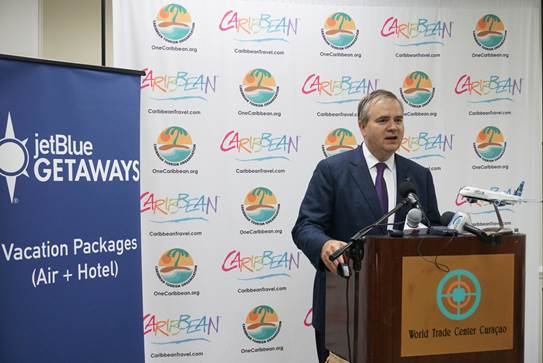
ROBIN HAYES ADDRESS TO THE CARIBBEAN TOURISM ORGANIZATION’S STATE OF THE INDUSTRY CONFERENCE WILLEMSTAD, CURACAO | OCTOBER 22, 2015
As prepared, not necessarily as delivered
WELCOME
Thank you, Mr Riley. Your excellencies, dignitaries, ladies and gentlemen, all protocols observed…
It’s a pleasure to be here. And thank you for the warm welcome and the invitation to speak here today in Curaçao. I’m delighted to be here with all of you in this beautiful destination.
Before I begin, I want to also recognize the JetBlue team in attendance – please stand! First I’d like to acknowledge Frank Bisslik, JetBlue’s General Manager for Curaçao and Aruba and the Supervisor of our operation at Curaçao Airport, Cedric Jonis. Thank you for all you do to represent JetBlue and serve our customers so well in this part of the Caribbean.
We also have several members of the team here from JetBlue Getaways, our vacations business, including Umang Gupta, who leads this group, and Wendy Juengerkes and Julia Washington. I hope over the course of the next two days you’ll have a chance to speak with the team to learn more about what makes our offering so unique.
Jeff Goodell is with us today; he is our Vice President of Government and Airport Affairs. We also have Elizabeth Ninomiya and Sebastian White from our communications team.
Finally, Dave Clark is in the audience; he’s our Vice President of Network Planning and he is the guy who can make all your route dreams come true. I am sure he will be a popular person today!
ABOUT JETBLUE
By a show of hands, how many of you here have flown JetBlue?
Let me offer a bit of history about our company for those of you who may not be as familiar with JetBlue. This year we’re celebrating the 15th anniversary of our very first flight from New York to South Florida. We’re a relatively young carrier that has always taken pride in innovating and doing things a little different from the rest of the pack.
When JetBlue was being envisioned back in the late 1990s, the original business plan called for an all-coach, all-domestic, single fleet airline. If you think back to that time, flying was, frankly, the pits. Our founders saw an opportunity to create an entirely new kind of airline that would break the mold and restore a bit of the glory of flying. They set a lofty mission for the brand – to bring humanity back to air travel. This required a very different approach than our competitors had been taking – to think of ourselves not just as an airline but a customer service company that happens to fly planes. Today, that focus on people remains the heart of everything we do. -2-
If you look back at how the aviation industry has shaken out over JetBlue’s lifetime, the only constant has been evolution. There has been an incredible amount of churn and change that has reshaped the landscape, particularly in the United States. When JetBlue was founded there were ten major airlines in the US; over time, each one of those carriers merged – some more than once – and today those ten airlines are now four megacarriers that control 80% of the US market. JetBlue, on the other hand, remains a bit of an underdog with just 5% of the market.
JetBlue is the only major airline other than Alaska Airlines that has not gone through bankruptcy or merger since the US industry was deregulated in 1978.
When you’re such a small carrier going head-to-head with these goliaths in a landscape that has shifted so significantly, it requires an innovative spirit and a lot of tenacity. For JetBlue, it has also required rethinking WHERE we do business and making the choice to take a leap and do something that wasn’t in the cards when we were being incorporated: serve the Caribbean, and do so in a big way.
JETBLUE IN THE CARIBBEAN
It’s now been 13 years since our first flight to the region – a bit of a humble start with a single route from our home base at Kennedy Airport in New York to San Juan. As an airline based in the Big Apple, with its huge Puerto Rican-born population, this market was a natural fit and maybe a safe bet for us to begin exploring the region.
The success of San Juan gave us the confidence to dip our toes a bit deeper in the waters of the Caribbean Sea, if you will, and go international. In 2004, we launched service to The Bahamas and Dominican Republic. From Nassau and Santiago, I don’t think anyone could have predicted just how quickly our Caribbean growth would accelerate and how significant this part of the world would become to our network in the ensuing years.
From day one, JetBlue’s model has been about identifying markets that are underserved, overpriced – or both – and stimulating traffic with lower fares and a higher standard of service. It didn’t take long to see that the Caribbean presented the same sort of growth opening we’d seen in the US domestic marketplace.
We’ve added destination after destination to the point that we now serve 27 airports from Bermuda to Barbados and Grand Cayman to Grenada. Our 28th destination – Antigua – will come online two weeks from today. These vibrant, unique communities are so critical to our success. In fact, today one-third of our airline’s capacity is now devoted to serving offshore markets in the Caribbean and Latin America. Much of this growth has come as a result of Open Skies agreements which allow us to freely add flights and give consumers choice. In addition to our own flying, we also have important relationships with regional partners like Cape Air, LIAT, and Silver Airways, and just yesterday we were delighted to expand our partnership with Seaborne Airlines to a codeshare.
We’ve seen an incredible competitive shift in the region as a result of JetBlue’s growth. We’ve succeeded in places where our legacy competitors had maybe become a bit too complacent, and we’ve also built entirely new markets that had never been flown before. Consumers vote with their wallets and time and again they’ve chosen JetBlue. -3-
We are incredibly appreciative of the support we’ve received across the region. We are also very mindful of respecting the trust we’ve developed over the years. We know we cannot ever take for granted the business we receive here!
JetBlue doesn’t fly to every Caribbean destination – yet – but we DO serve Cuba, one of the hottest topics of the tourism trade. Ever since the US and Cuba eased relations earlier this year, I’ve been asked when we’re going to start flying to Cuba.
Well, we’re already there and we have been since 2011 with charter flights from Florida and as of this summer, from New York, as well. This has given us a tremendous amount of operating experience that will give us a leg up when our countries sign an aviation treaty that will pave the way for scheduled service.
There’s a lot of excitement about Cuba opening up to Americans, but also some concern about what that might mean for the rest of the region’s tourism sector. The Cuban market is sure to expand significantly once regularly scheduled flights from the US begin, but I don’t expect this growth to come at the expense of other islands – it certainly won’t for JetBlue. We’re not going to pick up all our planes and move them to Cuba.
I was in Havana earlier this year on a trade mission with the Governor of New York and other business leaders from our state; it is a fascinating destination with a lot of beauty and intrigue. However, the infrastructure needs to support any influx of tourists are massive. It’s going to be a long time before Cuba’s full potential is realized. These transformations do not happen overnight.
Until then, we will continue our focus on expansion where we see the greatest opportunity – and there is plenty of that across this region.
In the next year and beyond, you can expect to see JetBlue enter several new markets. On our most popular routes we’re going to lay on additional frequencies or deploy our larger A321 aircraft which are being delivered at a rate of about one per month. We’re already seeing these new jets in busy markets like Montego Bay and Punta Cana.
Earlier this week we announced plans to bring the 321 to Port-au-Prince and to increase flights from Boston, New York and Fort Lauderdale in response to growing demand for travel to Haiti – and that includes a growing element of tourist traffic. In total, we will increase our service to Haiti by more than 50,000 seats, an increase of 80% since JetBlue initially entered the market two years ago.
Next year we have 10 new aircraft entering our fleet and the year after that, in 2017, we have another 10 coming. We need places to point all those planes and a lot of them are coming south to the Caribbean.
One big difference in our model is our focus on offering ‘fair fares.’ We have a desire and the ability to add capacity when we see fares creeping up. Haiti is a good example of that. By offering more seats, we can offer more low fares and support tourism growth. This is very different to the traditional legacy model of keeping fares high.
I mentioned earlier that international flying was a departure from our original all-domestic business model. Last year we made another tweak to the blueprints of our airline. On select aircraft we added a really innovative business class experience called Mint. It has fully lie-flat seats – some are even semi-enclosed in private suites – plus delicious, interesting cuisine and an unparalleled level of hospitality. -4-
Mint was created to allow us to compete the in premium market on busy transcontinental routes between New York and California by offering much lower fares and better service than our competitors had been offering. This is exactly the same formula we’ve used to expand across the Caribbean with our traditional product. Mint has been a runaway hit so this winter we will bring it to the Caribbean for the first time with service from New York to Aruba and Barbados and from Boston to Barbados. After a great holiday in one of these destinations, our customers will be able to continue the experience onboard with regional dishes like pan-seared flying fish and jerk pork tenderloin.
Since we’re here in the Caribbean and one of my favorite things to do is announce more flights, let’s do a couple – what do you think?!
First off, I’m delighted to share that we’ll be expanding our service between Curaçao and New York with a third weekly flight next year. We have only been here since December but this island has quickly proven to be a big hit with our customers. We are thrilled to join with our friends at Curaçao International Airport to make it even easier to get here.
That’s not all! I am excited to also announce an entirely new market for JetBlue. Beginning in April 2016 we’ll offer daily nonstop service between Barbados and our focus city at Fort Lauderdale-Hollywood International Airport in South Florida. This will be our 75th route between the US and the Caribbean.
Both Barbados and Curaçao are terrific examples of destinations where we have a true partnership with the ministries of tourism and airports. When you’re weighing network decisions, it’s a whole lot easier to choose to grow in communities that truly value and understand the positive impact an airline like JetBlue can have on their market.
In the US, not everyone understands the extent to which commercial aviation drives the economy. For instance, we’re seeing attempts to re-regulate the industry through government mandates for things like baggage fees and seat pitch. We’re closely watching these developments and how they could impact our business.
Regulation factors into our route planning decisions, and so does the tax burden our customers face when buying airplane tickets. There is a wide range of passenger tax regimes across the region. I would encourage those of you who have influence in this sphere to carefully consider how taxies are levied and to use this option sparingly. At JetBlue we are very much thinking about the relative tax burden on our customers as we allocate capacity.
Between US and foreign taxes and fees, travelers can easily be hit with an extra 150 US dollars on top of their airfare – that could be an entire extra hotel night. Contrast that to the average JetBlue airfare for the first six months of this year which was just $171. We would rather customers have more money in their pocket to spend when they arrive in your communities.
JETBLUE GETAWAYS
Speaking of that – when our customers arrive in the Caribbean, they of course need a place to stay, they need places to eat, they need things to do, and they need local guides. We want to help connect all these pieces of the travel puzzle and that’s why we’re pouring a lot of resources into expanding our vacations business, JetBlue Getaways. -5-
Today, we fly nearly 150 trips a day into the Caribbean and Latin America, but only a fraction of our customers have paired their flight with a hotel or other extras through a Getaways package. We think there’s a big opportunity to grow this part of our business. People already trust the JetBlue brand to get them from Point A to Point B, so why not extend that relationship into other areas of their itinerary?
While flying is easier than ever, the rest of the trip can be hard to plan and is sometimes subject to inconsistent service. We already have a culture of hospitality at JetBlue, so we want to use it to create a more personal and helpful travel service. We hope to give our customers the confidence to know that when they book through Getaways their end-to-end journey will be as memorable as their JetBlue flight.
Today, we see far more holiday packages being bundled through online travel agencies than through Getaways and our own lower-cost channel at jetblue.com. Just as the airline industry has consolidated into a few mega players in the past decade, the distribution business is becoming even more consolidated in the hands of a few players. When the deal is sealed on the big merger that’s been proposed, there will be just two players left who combine to control 95% of OTA bookings in the United States.
A big drawback of travel giants is that they give consumers an almost dizzying number of choices when it comes to a holiday. If you go online and do a hotel search for this weekend in either Aruba or St. Maarten, for instance, you’ll find nearly 100 hotel options to wade through. Where do you even start? For a traveler who may not be familiar with a destination, that number is staggering.
As we grow Getaways, we intend to limit the number of properties in our portfolio, to a hand-picked selection that represents the same kind of quality and attention to service that our customers receive in our airports and on our flights. Our aim is to be the preferred partner for hotels and other tourism providers and to seek out the kind of businesses that will ensure our customers have a great 360-degree JetBlue experience.
Another advantage of Getaways is our personalized approach that removes some of the anonymity that travelers face when they book through bigger operators. We want to have our imprint on every step of the journey. And if something goes wrong, we want to be there to make it right.
In a nutshell, the biggest difference between JetBlue Getaways and other tour packagers is relationships – we look at these quite a bit differently than our competitors. We understand that we can’t thrive without solid partnerships with all of you. We need each other in order to be successful. We make a JetBlue promise to our customers and we want to offer the same kind of experience to you as partners.
So why is Getaways growth important to your destinations?
If we can encourage more travelers to book their JetBlue flight through Getaways rather than a competing service, that will help lift the overall profitability of our Caribbean routes. That’s critical because it will allow us to turn around and add even more capacity to your destinations. Talk about a win-win!
I’ll give you a couple examples.
In June we inaugurated service to Grenada with just two flights per week. Thanks to strong bookings through Getaways and greats friendships with local properties like Sandals and Spice Island, we were able to add a third weekly service in September, after only three months in the market. -6-
It’s interesting that we’re here in Curaçao, because for Getaways, this destination happens to be one of our most successful. In fact, 20% of our customers on the average JetBlue flight to Curaçao are booking their hotel and other elements of their holiday through Getaways. That’s a big reason why we have the confidence to also begin a third weekly trip in this market.
Our goal is to grow JetBlue Getaways to 2 million room night bookings per year by the end of the decade.
How are we going to get there?
First, we have some education to do to let travelers even know Getaways exists and show them how it differs from the other guys. Most people flying JetBlue already book their flights directly with us, so why not add a hotel at the same time?
Another lever we might pull is to limit our flight inventory to our own channels, especially during peak holiday periods. On the flip side, our ability to discount seats when there are empty seats and also empty rooms is a positive for all of us. This truly differentiates JetBlue against wholesalers or tour operators.
Second, we are making an investment in account management staff to support our relationships. We want to be fast and responsive to your needs. We are also investing in technology to improve our ability to market to the JetBlue customer base as well as to create innovative new solutions that create a better and more seamless customer experience.
Of course, we’re all ears when it comes to how we can best partner and make JetBlue Getaways your most valued partner. Our team is on site here today. Please do not by shy letting them know how we’re doing, and how we can better serve you and your guests.
SUSTAINABILITY
Before I come to close, I want to connect our business and presence here with something that is all around us, and yet often overlooked. That is the natural resources of this beautiful region, its beach environment.
The Caribbean is your home, and it is also the region we rely on for about one-third of our company’s business. People come from around the globe for the pristine water and the unspoiled beauty of these destinations. At JetBlue, we have a huge stake in ensuring the waters and the landscape is valued and preserved for the long-term.
Unfortunately, too often around the world, governments fail to see the link between cleaning up beaches and oceans and their economic vitality. No one benefits when oceans and beaches are polluted, yet these problems persist around the world.
We recently partnered with The Ocean Foundation to explore this idea as it relates to the Caribbean Basin and to try to prove, once and for all, the economic value that results from healthy shorelines. We wanted to connect with hard data the importance of nature to our airline’s main economic measure – revenue per available seat mile, or RASM.
By attaching actual dollar values to unspoiled shorelines, we are creating the business case for communities to better protect the ecosystems we depend on and promote the economic importance of shoreline conservation. There appears to be a strong correlation with what the tourism industry considers obvious – the nicer the beach, the nicer the hotel, the more expensive the airline ticket might be. Nothing -7-
spurs governments or businesses to action like hard data, but until now, none has really existed on this concept.
On this point, I’ll just add that the concept of the traditional idea of who is an ecotourist is outdated. It’s no longer someone who comes to surf, dive, or explore the rainforest. Indeed, every single person who comes to the Caribbean for its turquoise water and white beaches is an ecotourist. It’s time we make the appropriate investments to protect this revenue stream and invest in the health of our oceans and beaches. Our Sustainability team is working hard to advance this thinking around the region.
CLOSE
To close, I just want to thank you all for having me here today and extend my deep appreciation to all of you for helping power JetBlue’s success across the region over the past decade. We could not have gone from zero to 28 Caribbean destinations without an incredible amount of support and partnership from many of you in this room.
And remember: please don’t hesitate to speak with our team on site this week. I wish you all a terrific conference!






